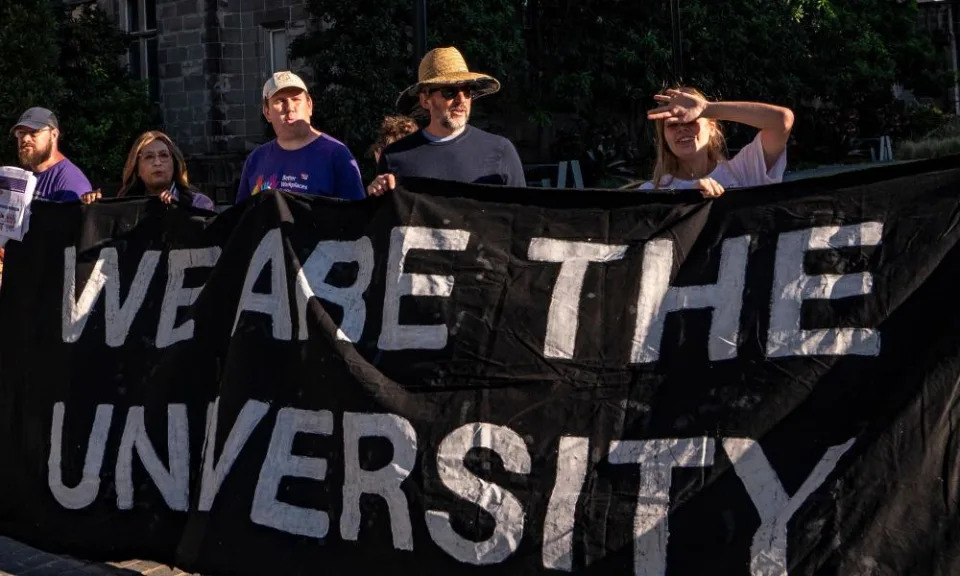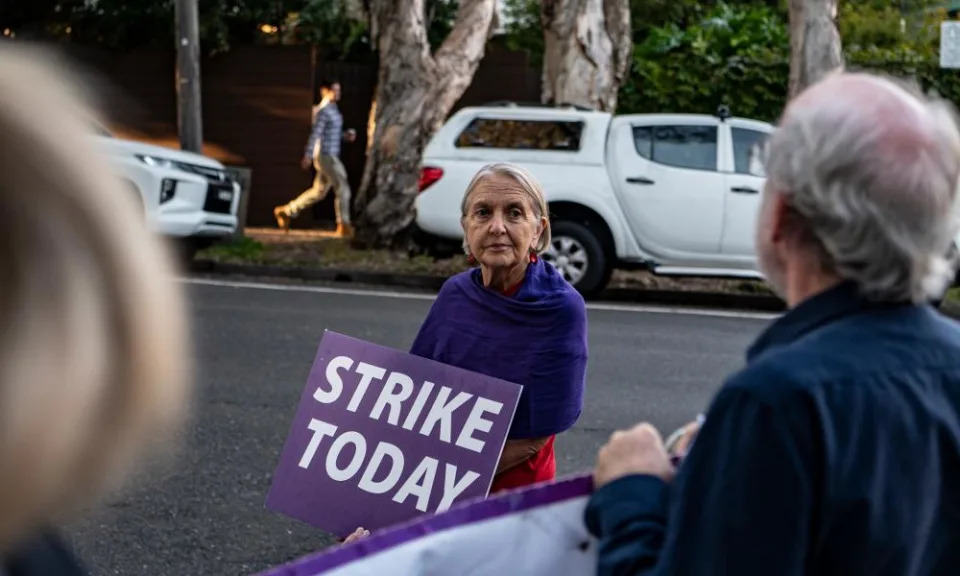Caitlin Cassidy
Sun, 2 April 2023

Photograph: AAP
The usually bustling University of Sydney campus is a ghost town on Friday morning, aside from a groundskeeper on his lawnmower and the occasional police car.
One hundred metres down the road, though, dozens of union members are belting out Red Flag and The Internationale to the toots of trucks and a chemistry lecturer’s french horn.
Related: Australian universities advised to avoid being ‘roped into’ multi-employer bargaining, leaked strategy reveals
Friday was the eighth day of strikes since an epic 21-month enterprise bargaining process began.
Hundreds of staff gathered to block off nine main entrances to the campus on Friday to reject management’s latest enterprise agreement proposal, representing the longest industrial action at any university in Australia.
The National Tertiary Education Union (NTEU) say management has refused to implement satisfactory controls on staff workloads, and are calling for job-security for casual and professional staff, a reduction of education-focused roles and a parity target for Indigenous employment.
Under the current agreement, management has agreed to preserve the 40-40-20 model, ensuring academic loads are split evenly between research and teaching, with 20% of time allocated to administrative work.
But it’s pushing to create 650 education-focused positions with a 70% teaching workload, while new academic roles will be increased by 10% to 330 positions.
The education positions were rejected this week with “dismay and incredulity” by emeritus professor Derrick Armstrong, who was responsible for introducing the roles and says they’ve become a way to reduce costs for the university while detaching the value of research from education.
At the picket at the Ross Street entrance, music blares all day, and students join staff armed with banners, flags and instruments. If the stakes weren’t so high, it might almost feel like a party.
Alma Torlakovic, member of the NTEU branch committee, is running the Ross Street picket. “We’re teaching a new generation of students how to fight,” she says.
“We’ve just had two unprecedented meetings in a row … it’s boosted people’s energy and spirit.
“Most staff would agree … people with any kind of job security have the best wages and conditions [nationally]. That’s what’s inspiring people to come out and lose pay – they know what’s at stake.”
A record 700 members attended the NTEU’s latest meeting to vote broadly in favour of a further eight and nine days of industrial action.
It came after management’s latest offer, which outlined a 17.1% pay increase over three years and a $2000 sign-on bonus.
A spokesperson for the University of Sydney says the pay increases are the best in the sector and it’s “disappointing” the union voted to continue with industrial action.
“Throughout the protracted negotiation process, we have never once modified our position due to industrial action, but only in response to good-faith negotiation at the bargaining table,” they say.
“The unions put forward more than 100 claims in this negotiation, more than any other university in Australia has had during similar negotiations.”
For classes going ahead in person, “roaming” strikers use interference tactics to “Zoom picket” tutorials and disrupt lessons. Where classes are running, normal attendance policies apply, while cancelled classes don’t rack up absences.
Yasmine Johnson is one of about 200 students at the university who’ve come out in support of academics.
“The things staff are facing, actually affects students too … they’ve [management] been trying for years to make classes bigger, meaning that tutors don’t have time to really mark students’ work,” she says.
“Student definitely understand. Lots of them stay at home for the strike days [and] students have been going around to classes before the strike and getting them to vote in support.”

Members of the NTEU at the University of Sydney on Friday, the eighth day of strikes since the 21-month enterprise bargaining process began. Photograph: AAP
Senior coordinator at the Faculty of Medicine and Health Dr Jason Todd is at the Carillon Avenue picket, dressed in the union’s purple. He’s running a clinical trial on prostate cancer and says his department is struggling to retain staff.
“Workloads are getting out of control … it’s hard to hire people when you can get much better offers in the private sector,” he says. “People are burnt out.”
Related: Australian university sector makes record $5.3bn surplus while cutting costs for Covid
Nick Riemer, NTEU branch president at the university, tours the picket lines on his pushbike.
He says some university cohorts, including the business school and law faculty, which were not previously active in industrial matters, have been radicalised during this campaign.
“We can’t go on striking forever, but we have to until we meet our minimum objectives … and we haven’t got that yet.”
This story was amended on 3 April, 2023 to correct that the University of Sydney’s pay increase offer is over three, not four, years.
He says some university cohorts, including the business school and law faculty, which were not previously active in industrial matters, have been radicalised during this campaign.
“We can’t go on striking forever, but we have to until we meet our minimum objectives … and we haven’t got that yet.”
This story was amended on 3 April, 2023 to correct that the University of Sydney’s pay increase offer is over three, not four, years.

No comments:
Post a Comment